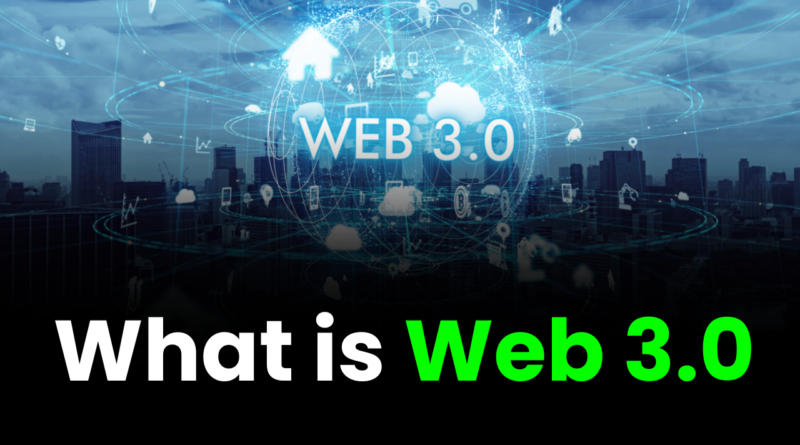What is Web 3.0 ?| CodeWithShani
Web 3.0 is the next iteration of the internet, and it is poised to be a game-changer in the world of technology. Often referred to as the “semantic web,” Web 3.0 is characterized by its focus on data, artificial intelligence, and machine learning. In this article, we will explore the concept of Web 3.0 in detail and discuss its potential implications for the future of the internet.

Introduction
Web 3.0 is a term that has been used to describe the next generation of the internet, one that promises to be more intelligent, more efficient, and more useful than its predecessor. While the first iteration of the web (Web 1.0) was characterized by static pages and simple HTML, and the second iteration (Web 2.0) was characterized by social media, user-generated content, and interactive websites, Web 3.0 is poised to take things to the next level.
The Origins of Web 3.0
The concept of Web 3.0 was first introduced in 2001 by Tim Berners-Lee, the inventor of the World Wide Web. At the time, Berners-Lee was concerned that the internet was becoming too fragmented, with data scattered across different sites and services. He believed that the next iteration of the web should focus on data integration, making it easier for people to find, share, and use information.
Since then, the concept of Web 3.0 has evolved to encompass a broader range of technologies and ideas. Today, it is commonly associated with artificial intelligence, machine learning, the Internet of Things, and decentralized technologies such as blockchain.
The Key Features of Web 3.0
Web 3.0 is characterized by several key features, which set it apart from previous iterations of the web. These include:
The Semantic Web
The semantic web is a concept that refers to the idea of making data more understandable to machines. In other words, it involves creating a web of data that can be easily read and interpreted by computers.
The semantic web is achieved through the use of metadata, which provides additional information about the content on a website. This, in turn, makes it easier for machines to process and understand the data.
Artificial Intelligence and Machine Learning
Artificial intelligence (AI) and machine learning (ML) are two technologies that are set to play a significant role in Web 3.0. AI refers to the ability of machines to mimic human intelligence, while ML refers to the ability of machines to learn from data. These technologies can be used to automate a wide range of tasks, from data analysis to content creation.
Decentralization
Decentralization is a key feature of Web 3.0, and it refers to the idea of distributing data and processing power across a network of computers. This is achieved through the use of technologies such as blockchain, which provides a secure and transparent way to store and share data. Decentralization can help to prevent data breaches and ensure that data is accessible to everyone.
The Internet of Things
The Internet of Things (IoT) is a concept that refers to the idea of connecting everyday objects to the internet. This can include anything from smart home devices to industrial sensors. The IoT can be used to collect and analyze data from a wide range of sources, which can be used to improve efficiency and productivity.
Benefits of Web 3.0
Web 3.0 has the potential to offer several benefits, both for businesses and individuals. These include:
Improved Data Integration
One of the primary benefits of Web 3.0 is improved data integration. By making it easier for machines to read and interpret data, Web 3.0 can help to create a more interconnected web of information. This, in turn, can lead to more efficient decision-making and improved productivity.
Increased Efficiency
Web 3.0 can also help to increase efficiency in a number of ways. For example, by automating tasks through the use of AI and ML, businesses can reduce the time and resources required to perform certain tasks. Additionally, by using the IoT to collect data from a wide range of sources, businesses can gain a more comprehensive understanding of their operations, which can help to identify areas for improvement.
Improved Security
Decentralization, a key feature of Web 3.0, can also help to improve security. By distributing data and processing power across a network of computers, it becomes more difficult for hackers to breach a single point of entry. Additionally, technologies such as blockchain provide a secure and transparent way to store and share data, making it more difficult for bad actors to tamper with the information.
Enhanced User Experience
Finally, Web 3.0 has the potential to enhance the user experience in a number of ways. For example, by using AI and ML to personalize content and recommendations, businesses can create a more engaging and relevant experience for their users. Additionally, the semantic web can help to make it easier for users to find the information they need, by providing additional context and metadata.
The Challenges of Web 3.0
While Web 3.0 has the potential to offer significant benefits, it also presents several challenges. These include:
Data Privacy
As more data is collected and processed through Web 3.0 technologies, there is a risk that user privacy could be compromised. It will be essential for businesses to implement robust data privacy policies and security measures to protect user information.
Technical Complexity
Web 3.0 technologies are complex and require a high level of technical expertise to implement effectively. This can be a barrier to entry for smaller businesses and startups, who may not have the resources to invest in these technologies.
Regulatory Challenges
As with any new technology, Web 3.0 will also face regulatory challenges. Governments and regulatory bodies will need to develop new frameworks to ensure that these technologies are used ethically and responsibly.
Adoption
Finally, widespread adoption of Web 3.0 technologies will be essential for them to realize their full potential. However, as with any new technology, there may be a period of skepticism and resistance before these technologies become mainstream.
Summary
Web 3.0 is the next evolution of the internet, and it promises to be a game-changer in the world of technology. By focusing on data, artificial intelligence, and decentralized technologies, Web 3.0 has the potential to offer significant benefits for businesses and individuals alike. However, it also presents several challenges, including data privacy, technical complexity, regulatory challenges, and adoption. As Web 3.0 continues to evolve, it will be essential for businesses and individuals to stay informed and adapt to these new technologies to stay ahead of the curve.




